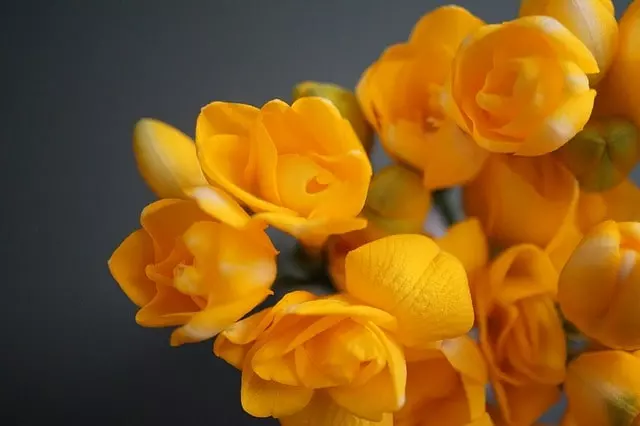The wonderful thing about planting freesia bulbs in the garden is that early we will have a wonderful amount of fragrant flowers, announcing the beginning of spring. Learn all about how to grow freesia in this article.
They are delicate, elegant, and subtly perfumed flowers, they are very appreciated as cut flowers, although they are also used in the industry of essences, both for making perfumes and for any other cosmetic product.
Freesias are native to Africa, where about 15 native species can be found. Their highest concentration is in South Africa, with 12 different species.
Table of Contents
Description
The freesia is an herbaceous plant that develops from a bulb.
From the bulb emerges a single stem, from which appear sheathed leaves arranged in a fan. From between the leaves appear the floral stems called raquis and the main leaves of the foliage.
Each raqui has a main flowering stem and two or more lateral stems in a lower position.
They are dark green plants, which enhances their beautiful flowers.
They reach a height of about 32″ (80 cm) in conditions of good fertility.
If we want to have upright flowering stems, we must stake the freesia, as it tends to lie down when the flowers appear.
Trellising is necessary to facilitate air circulation between the plants and to avoid the appearance of fungus.
Freesia Flower
Freesia flowers stand out as one of the 10 most perfumed flowers, competing with honeysuckle, gardenia, hyacinth, or jasmine.
Its fresh and sweet perfume is widely used in perfumery and cosmetics, but not as the main perfume, but as a modifier of other deeper fragrances.
Its flowers are arranged in unilateral spikes. They have an irregular bell shape and are about 1.2″ or 1.6″ (3 or 4 cm) in diameter.
Each spike can have between 5 and 8 single or double flowers.
You can find double or single freesia flowers in a large number of bright colors: pure white, yellow, pink, orange, red, blue… with white and yellow freesias being the most fragrant. Keep this in mind when choosing which freesia bulbs to buy.
Flowering begins 10 to 12 weeks after planting. We can extend flowering for several weeks if we stagger the planting…as you will see below, they can be planted from fall to early spring.
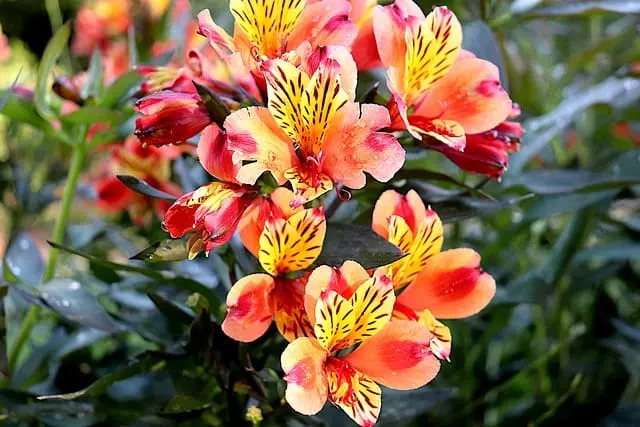
Cut Freesia Flower
Gardeners don’t usually like to cut flowers from their garden very much, I don’t either. But I have my trick for having fresh-cut flowers, growing a few on the side with the sole intention of cutting them.
The success of freesia as a cut flower is because they last a long time and they perfume any room you put them in. To make your cut flowers last longer, here are a few tips:
- Flowers should be cut early in the morning before it starts to get hot. This way they keep much longer and do not lose freshness.
- Cut the spike from its birth, when the lower flower of the spike is half-open, the rest of the flowers will open gradually.
- Every day cut the stem of the flower spike a little, with a slight inclination so that the water absorption surface is greater. Cutting daily has an explanation, the cuts tend to scar, preventing the flower stem from absorbing all the water the flower needs.
- Add a flower preservative to the water. They contain disinfectants and food that will help eliminate any parasites, and your flowers will look perfect for much longer.
- One option (although not as effective) is to add a couple of dissolved aspirin to the water.
- If you don’t use preservatives, change the water daily.
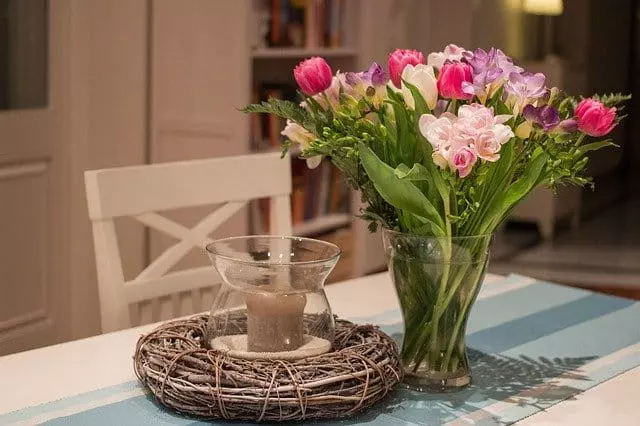
How to Grow Freesia
In South Africa, freesia is planted in autumn, producing winter flowers at temperatures around 50 °F (10ºC).
If your climate is rather temperate, you can plant perfectly well during autumn, you will have your first freesias in late winter or early spring.
Freesia bulbs do not tolerate frost. If you live in a place where frost is common, you have the option of planting the bulbs in pots and moving them indoors or planting in the garden directly at the end of winter.
The most commonly cultivated in gardens is freesia hybrid, obtained from crosses between freesia refracta, freesia leictlinii, freesia corymbosa, and a series of other freesias, from which the commercial cultivars we use in the garden have been obtained.
How to Grow Freesia Step by Step
Success with growing freesia has a lot to do with its planting. If you follow this growing guide, you won’t have any problems:
- The growing depth for freesia is about 2″ (5 cm), as the freesia bulbs is small.
- Between bulb and bulb, you should leave about 2.75″ (7 cm), although they can be a little more together if the bulbs are not very big.
- Before placing the bulbs in their final place, make a small plan of the plantation. Try to plant small groups of bulbs, so that the final result has a wild atmosphere.
- The stems of freesias are prone to toppling over under the weight of the flowers. Place stakes to support the flowering stems.
- Be careful when placing the bulbs in their holes, the bud must be pointing towards the surface.
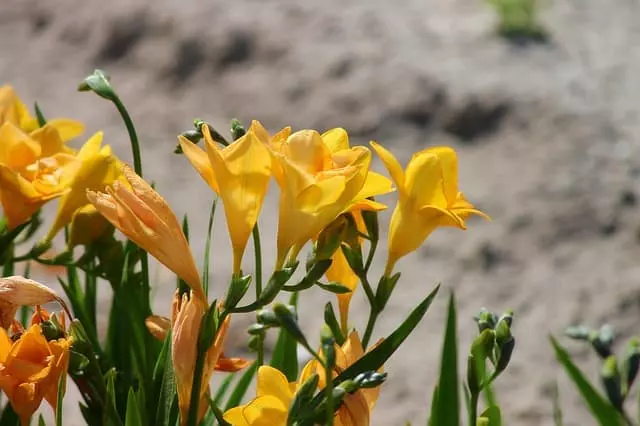
How to Care Freesia
Although the process of planting is very important for freesia, it is no less important the preparation of the soil, choosing the location, watering … but above all, you must remember that they do not tolerate the cold, so you have to choose very well the time of planting.
How to Grow Freesia – Soil
Freesias prefer loose, slightly acid soils with a large amount of organic matter.
To get that looseness, you should move the soil to about 10″ (25 cm) deep, adding a good amount of compost.
Sun Exposure
If our climate is temperate, freesias can be perfectly in full sun, but if temperatures are high, the best location for the freesia is in semi-shade, where the flowers will last much longer.
In any case, it should avoid the midday sun, which can be the most harmful.
How to Grow Freesia – Watering
Throughout the article, you will have seen that we can have freesias during most of the spring, until well into the summer.
This staggered cultivation offers us different watering needs. As a rule, the freesia does not like waterlogged soils, where its bulbs can suffer, however, they do need the soil to retain moisture during growth and flowering.
Once it has flowered and the plants lose their leaves, we must suspend watering.
Fertilizing
If the soil has been well prepared or if the freesia has been planted in pots and a good quality compost has been used, it will not need a lot of extra nutrients.
In any case, it is advisable to apply a complementary fertilizer just before flowering.
To grow freesia we recommend the use of this fertilizer (Order it here). We had excellent results with the freesia crop using this product.
- FOR USE ON: Use Bulb-tone organic fertilizer for all Fall bulbs like tulips, daffodils, crocus & hyacinths and on Spring bulbs like gladioli and lilies
- CONTAINS: Bulb-tone is a rich blend of the finest natural & organic ingredients enhanced with our exclusive Bio-tone formula; 3-5-3 Fertilizer analysis with 6% Calcium. Bulb-tone is environmentally Safe - No sludges or toxic ingredients
- WHEN / HOW TO USE: Best to use Bulb-tone fertilizer when planting or feeding post bloom on spring flowering bulbs; place directly in the planting hole for new bulbs and sprinkle on the soil surface for established plants then water thoroughly. Bulb-tone is ready to use and requires no mixing
How to Grow Freesia – Pests
Freesias are not plants that usually suffer many attacks, although they can always be exposed to garden pests:
- Red spider mite. They appear due to an excessively dry environment and are more frequent in strawberries grown in greenhouses. To prevent their appearance, it is advisable to maintain humidity in the environment.
- Aphids. Aphids in the garden and spring are very difficult to avoid aphid attacks. If we catch them in the first stage, with a hosepipe we get rid of them, but if we are already talking about plague we must use appropriate fungicides.
- Snails and slugs. They are lovers of tender shoots, and it is also difficult to prevent them from appearing in the garden…but we can prevent them from eating the plants by placing beer traps or adding wood ash around the plants.
Pests, being very annoying, are the least of the problems we could have in the cultivation of freesia. The worst is the appearance of fungi, which we will detect if we observe stained or striped leaves.
- Fusarium. We will detect its appearance if we observe that the leaves dry, the roots and the bulbs also dry (not after flowering, which would be logical). There is no solution, the best thing to do is to get rid of the affected bulbs.
- Brotitis, gray mold. If the freesia has been attacked by Brotitis, gray spots will appear on the leaves and flowers. The solution is to remove the damaged parts and dispose of them.
How To Propagate Freesia
Freesias can be propagated by the multiplication of their bulbs or by seeds.
Multiplication from bulbs is the most common in the garden, only growers looking for large-scale production or to produce new varieties usually multiply freesia by seeds, but you should know all the options.
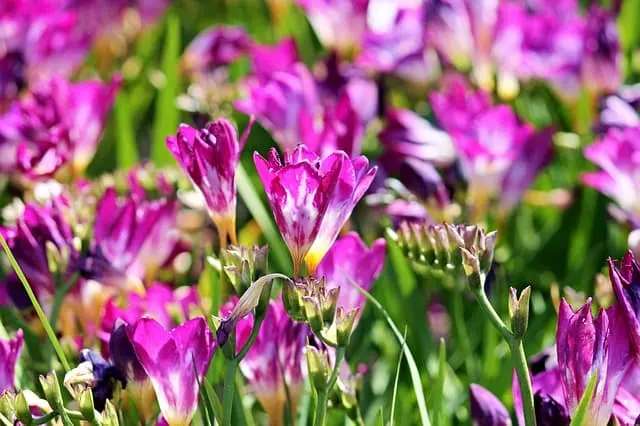
Propagate Freesia by Bulb Separation
The multiplication of the bulbs, as with all bulbous plants, is spontaneous. Small bulblets will appear under the main bulb, which must be removed carefully so as not to damage it.
It is also possible to find small useful bulbs under the axils of the lower leaves of freesia.
These bulbs, we will have to plant the following year, to fatten and obtain sufficient size to bloom. This flowering usually takes place after two years.
If you want to grow quality freesia from bulbs we recommend these (Order it here).
- Fragrant/Delightful cut flower/Long lasting flowers
- Freesias are visually stunning, blooming in abundant clusters with up to eight trumpet-shaped, upward-pointing blossoms on leafless stems
- Bulb Size: 6/+ cm/Exposure: Full sun to partial shade/Blooms: In Summer/Plant Time: Fall & Spring
Propagate Freesia by Seeds
The multiplication of freesia by seeds is not the usual, because it requires certain knowledge and much, much patience.
If we do not cut the flowering stems, the flowers of the freesia are encapsulated generating seeds inside.
The seeds will be ripe and ready to be harvested when the capsule begins to open. They will be collected and stored in a dry and dark place until the following year.
The process of planting freesia from seed is as follows:
- Keep the seeds soaked one day before sowing. This step is important.
- We can sow them in pots during autumn or the garden at the end of winter, beginning of spring.
- In any case, the seedbed should contain a good amount of organic matter from mature manure. If you buy it packaged it will be free of any other type of seed.
- We will mix two parts of vegetable mulch, one part of peat, one part of sand, and one part of mature manure. Mix well.
- We will put the first layer of compost and add the seeds, which we will cover lightly.
- Water abundantly.
- When the first seedlings appear and have a size easy to handle, we will make a repotting, placing the small seedlings in pots or the garden.
- At this point clarify: we will need at least three years for the strawberries obtained from seeds to have a bulb large enough to produce flowers. That is why this task is more for gardeners with a lot of hobbies and time.
If you want to grow quality freesia from seed, we recommend these (Order it here).
- A mix of lovely flowers in colors of blue, pink, white, and yellow can be grown from Freesia seeds. These blooming beauties capture your heart and are a springtime favorite. Freesia flowers are very fragrant, easy to grow and look great in pots and in garden beds where you want masses of color.
- Freesia is a 16 inch tall perennial growing in USDA zones 9 - 10 or as an annual in colder climates.
- Royal mix has large, delicate flowers often used alone in floral arrangements, or as contrasting blooms in a bouquet of other flowers, such as roses. For color, fragrance and elegant form, this Freesia mix is unbeatable. Excellent for pots or for sprinkling throughout an established bed. Grow Freesia flowers for cutting.
How To Store Freesia Bulbs
Professional freesia growers manage to emulate very well the life cycle of freesia bulbs: heat-cold-warm.
Through temperature-controlled storage processes, their bulbs bloom very well year after year and generate more bulbs.
We amateur gardeners can only hope to keep our bulbs and hopefully have a similar bloom the following year. It is difficult, freesia bulbs have no problem blooming the following year, but the flowering usually declines.
In any case, the way to preserve freesia bulbs is as follows:
- When the aerial part of the Fresia has dried, we will proceed to carefully dig up the bulbs so as not to damage them and to be able to collect all the bulbs that may have been generated.
- Be careful not to mix varieties and colors. Once prepared for storage, we will label them conveniently.
- After collecting the bulbs, we remove all the dirt. We will leave them to dry in a well-ventilated, dry, and shaded place for a few days.
- Once they are clean and labeled, we can store them in mesh bags (stockings will do), in a dry and dark place.
We hope this article on how to grow freesia will be useful. We recommend our article about How to Store Tulip Bulbs Step by Step.
